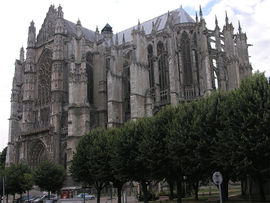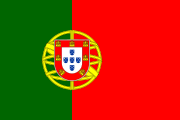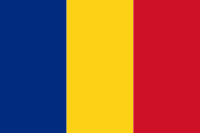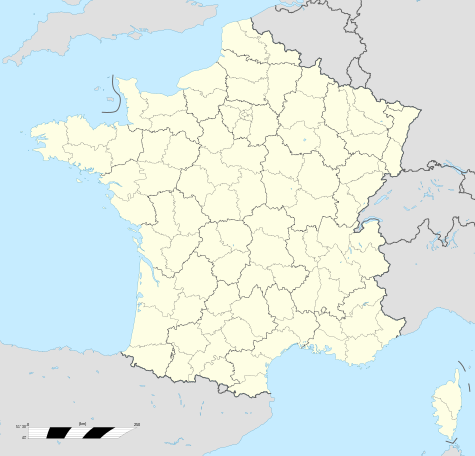Beauvais
|
Beauvais
|
 |
| Beauvais Cathedral |
|
|
|
| Administration |
| Country |
France |
| Region |
Picardy |
| Department |
Oise |
| Arrondissement |
Beauvais |
| Intercommunality |
Beauvaisis |
| Mayor |
Caroline Cayeux
(2001–2014) |
| Statistics |
| Elevation |
57–170 m (187–560 ft)
(avg. 67 m/220 ft) |
| Land area1 |
33.31 km2 (12.86 sq mi) |
| Population2 |
60,670 (2006) |
| - Density |
1,821 /km2 (4,720 /sq mi) |
| INSEE/Postal code |
60057/ 60000 |
| 1 French Land Register data, which excludes lakes, ponds, glaciers > 1 km² (0.386 sq mi or 247 acres) and river estuaries. |
| 2 Population sans doubles comptes: residents of multiple communes (e.g., students and military personnel) only counted once. |
History
Beauvais was known to the Romans as Bratuspantium a Gaulish name and by the Gallo-Roman name of Caesaromagus. The post-Renaissance Latin rendering is Bellovacum from the Belgic tribe the Bellovaci, whose capital it was. In the ninth century it became a countship, which about 1013 passed to the bishops of Beauvais, who became peers of France from the twelfth century. At the coronations of kings the Bishop of Beauvais wore the royal mantle and went, with the Bishop of Langres, to raise the king from his throne to present him to the people.
In 1346 the town had to defend itself against the English, who again besieged it in 1433. The siege which it endured in 1472 at the hands of the Duke of Burgundy was rendered famous by the heroism of the women, under the leadership of Jeanne Hachette, whose memory is still celebrated by a procession on the 14 October (the feast of Sainte Angadrême), in which the women take precedence over the men.
An interesting hoard of coins is known as the "Beauvais" hoard because some of the European coins found in the hoard are from the French abbey located in Beauvais.[1]
Geography
Beauvais lies at the foot of wooded hills on the left bank of the Thérain at its confluence with the Avelon. Its ancient ramparts have been destroyed, and it is now surrounded by boulevards, outside which run branches of the Thérain. In addition, there are spacious promenades in the north-east of the town.
Transports
Rail transport
The train station Gare de Beauvais, opened since 1857 is currently served by the TER lines:
- Beauvais - Persan-Beaumont - Paris Gare du Nord ;
- Beauvais - Creil ;
- Beauvais - Abancourt - Le Tréport.
Air transport
Beauvais-Tillé Airport, dating from 1930's, lies in north of the city, in Tillé. It is used as a gateway to Paris by several low-cost carriers. Traffic growth is significant: in 1997, 200 000 passengers used it, but by 2006, it was more than 1.8 million. Attendance at the airport increased by 40% a year on average between 2001 and 2005. The airport is mainly used for passenger traffic (only 2 to 3 flights involve freight each month) and serves 17 destinations. The main business lines are: Bergamo, Girona and Porto.
Public transport
The public transport in Beauvais is provided by the TUB (Transports Urbains du Beauvaisis, in English Transport for Beauvais). The transit bus (commuter bus) network consists of 25 regular lines which serve Beauvais and its suburbs, including:
- 12 day lines
- 1 2 3 4 5 6 7 8 9 12 13 14
- 3 Sunday lines.
- 3 summer lines.
- 10 (divided into 3 sub lines)
- 7 Demand responsive transport lines
- 3 shuttles
- Navette Aéroport (Airport Shuttle) Navette Parking (Parking Shuttle) Navette LaSalle (Polytechnic Institute of LaSalle Shuttle)
Green Plan
In an effort to promote cleaner transport and protect the environment, the city began to develop a "Green Plan" (Plan vert in French). Ultimately, the goal is to have a network of 20 km bicycle paths.
The Council for the future of the City of Beauvais also plans to establish a funicular line between Beauvais centre and Saint-Jean for 2015. The funicular of Beauvais will avoid walking to get to Saint-Jean and be environmentally friendly.
Beauvais Cathedral
Its cathedral, dedicated to Saint Peter (Cathédrale Saint-Pierre de Beauvais), in some respects the most daring achievement of Gothic architecture, consists only of a transept and quire with apse and seven apse-chapels. The vaulting in the interior exceeds 150 ft (46 m). in height.
The small Romanesque church of the tenth century known as the Basse Oeuvre occupies the site destined for the nave. Begun in 1247, under Bishop William of Grès (Guillaume de Grès, Guillaume de Grez), an extra 16 feet (4.9 m) were added to the height, to make it the tallest cathedral in Europe: the work was interrupted in 1284 by the collapse of the vaulting of the choir, a disaster that produced a temporary failure of nerve among the masons working in Gothic style. In 1573 the fall of a too-ambitious central tower stopped work again, after which little addition was made. The transept was built from 1500 to 154.
Its façades, especially that on the south, exhibit all the richness of the late Gothic style. The carved wooden doors of both the north and the south portals are masterpieces respectively of Gothic and Renaissance workmanship. The church possesses an elaborate astronomical clock (1866) and tapestries of the fifteenth and seventeenth centuries; but its chief artistic treasures are stained glass windows of the thirteenth, fourteenth and sixteenth centuries, the most beautiful of them from the hand of the Renaissance artist, Engrand Le Prince, a native of Beauvais. To him also is due some of the stained glass in St. Etienne, the second church of the town, and an interesting example of the transition stage between the Romanesque and Gothic styles.
During the Middle Ages, on 14 January, the Feast of Asses was celebrated in the Beauvais Cathedral, in commemoration of the Flight into Egypt.
Bishops of Beauvais
The early bishops of Beauvais are largely legendary, but a document records that the bishop who occupied the see from 632 to 660 was the thirteenth incumbent.[2] The see, near Paris and the centers of power, was a desirable one, being a prince-bishopric with the style of évêque-comte ('bishop-count') of Beauvais, and one of the few ecclesiastical original Peers of the realm of France of the kingdom, with the ceremonial privilege to bears the royal mantle at the coronation.
The most famous bishops of Beauvais are Odo of Beauvais (860-881) involved in a battle of prerogatives that was a foretaste of the Investiture Controversy; Gui (1063–85), who founded the great Beauvais school of theology at St. Quentin of Beauvais; Pierre Cauchon (1420–32), whose name is compromised in the condemnation of Joan of Arc; Jean Juvenal des Ursins (1433–44), the chronicler of Charles VI; Odet Cardinal de Châtillon (1535–62), brother of admiral Coligny, who turned Protestant at the Reformation; François-Joseph de la Rochefoucauld (1772–92), who died in the Carmelite prison in 1792; and François Hyacinthe Jean Feutrier (1825–30), minister of ecclesiastical affairs in the Martignac cabinet.
Other highlights
In the Place de l'Hôtel de Ville and in the old streets near the cathedral there are several houses dating from the twelfth to the sixteenth centuries. The hotel de ville, close to which stands the statue of Jeanne Hachette, was built in 1752. The episcopal palace, now used as a court-house, was built in the sixteenth century, partly upon the Gallo-Roman fortifications.
Birthplace of the mathematician Henri Lebesgue. In measure-theoretic analysis and related branches of mathematics, Lebesgue-Stieltjes integration generalizes Riemann-Stieltjes and Lebesgue integration, preserving the many advantages of the latter in a more general measure-theoretic framework.
Economy
The industry of Beauvais comprises, besides the state manufacture of tapestry, which dates from 1664, the manufacture of various kinds of cotton and woollen goods, brushes, toys, boots and shoes, and bricks and tiles. Market-gardening flourishes in the vicinity and an extensive trade is carried on in grain and wine.
The town is the seat of a bishop, a prefect and a court of assizes; it has tribunals of first instance and of commerce, together with a chamber of commerce, a branch of the Bank of France, a higher ecclesiastical seminary, a lycée and training colleges.
Beauvais also has a small airport, Beauvais Tillé, which is used by several low-cost carrier and charter airlines such as Ryanair as a terminal for nearby Paris, to which frequent shuttle buses run.
Sport
Beauvais is home to AS Beauvais Oise, a soccer club playing in the Championnat National (as of 2006).
International relations
Twin towns — Sister cities
Beauvais is twinned with:
 Maidstone, United Kingdom, since 1961
Maidstone, United Kingdom, since 1961 Witten, Germany, since 1975[3]
Witten, Germany, since 1975[3] Setúbal, Portugal, since 1982
Setúbal, Portugal, since 1982
Partnerships
There are also partnerships with:
 Dej, Romania, since 2003
Dej, Romania, since 2003 Tczew, Poland, since 2003
Tczew, Poland, since 2003
References
Notes
External links
Communes of the Oise department  |
|
Abancourt · Abbecourt · Abbeville-Saint-Lucien · Achy · Acy-en-Multien · Les Ageux · Agnetz · Airion · Allonne · Amblainville · Amy · Andeville · Angicourt · Angivillers · Angy · Ansacq · Ansauvillers · Anserville · Antheuil-Portes · Antilly · Appilly · Apremont · Armancourt · Arsy · Attichy · Auchy-la-Montagne · Auger-Saint-Vincent · Aumont-en-Halatte · Auneuil · Auteuil · Autheuil-en-Valois · Autrêches · Aux-Marais · Avilly-Saint-Léonard · Avrechy · Avricourt · Avrigny · Babœuf · Bachivillers · Bacouël · Bailleul-le-Soc · Bailleul-sur-Thérain · Bailleval · Bailly · Balagny-sur-Thérain · Barbery · Bargny · Baron · Baugy · Bazancourt · Bazicourt · Beaudéduit · Beaugies-sous-Bois · Beaulieu-les-Fontaines · Beaumont-les-Nonains · Beaurains-lès-Noyon · Beaurepaire · Beauvais · Beauvoir · Béhéricourt · Belle-Église · Belloy · Berlancourt · Berneuil-en-Bray · Berneuil-sur-Aisne · Berthecourt · Béthancourt-en-Valois · Béthisy-Saint-Martin · Béthisy-Saint-Pierre · Betz · Bienville · Biermont · Bitry · Blacourt · Blaincourt-lès-Précy · Blancfossé · Blargies · Blicourt · Blincourt · Boissy-Fresnoy · Boissy-le-Bois · Bonlier · Bonneuil-en-Valois · Bonneuil-les-Eaux · Bonnières · Bonvillers · Boran-sur-Oise · Borest · Bornel · Boubiers · Bouconvillers · Bouillancy · Boullarre · Boulogne-la-Grasse · Boursonne · Boury-en-Vexin · Boutavent · Boutencourt · Bouvresse · Braisnes · Brasseuse · Brégy · Brenouille · Bresles · Breteuil · Brétigny · Breuil-le-Sec · Breuil-le-Vert · Briot · Brombos · Broquiers · Broyes · Brunvillers-la-Motte · Bucamps · Buicourt · Bulles · Bury · Bussy · Caisnes · Cambronne-lès-Clermont · Cambronne-lès-Ribécourt · Campagne · Campeaux · Campremy · Candor · Canly · Cannectancourt · Canny-sur-Matz · Canny-sur-Thérain · Carlepont · Catenoy · Catheux · Catigny · Catillon-Fumechon · Cauffry · Cauvigny · Cempuis · Cernoy · Chamant · Chambly · Chambors · Chantilly · La Chapelle-en-Serval · Chaumont-en-Vexin · Chavençon · Chelles · Chepoix · Chevincourt · Chèvreville · Chevrières · Chiry-Ourscamp · Choisy-au-Bac · Choisy-la-Victoire · Choqueuse-les-Bénards · Cinqueux · Cires-lès-Mello · Clairoix · Clermont · Coivrel · Compiègne · Conchy-les-Pots · Conteville · Corbeil-Cerf · Cormeilles · Le Coudray-Saint-Germer · Le Coudray-sur-Thelle · Coudun · Couloisy · Courcelles-Epayelles · Courcelles-lès-Gisors · Courteuil · Courtieux · Coye-la-Forêt · Cramoisy · Crapeaumesnil · Creil · Crépy-en-Valois · Cressonsacq · Crèvecœur-le-Grand · Crèvecœur-le-Petit · Crillon · Crisolles · Le Crocq · Croissy-sur-Celle · Croutoy · Crouy-en-Thelle · Cuignières · Cuigy-en-Bray · Cuise-la-Motte · Cuts · Cuvergnon · Cuvilly · Cuy · Daméraucourt · Dargies · Delincourt · Le Déluge · Dieudonné · Dives · Doméliers · Domfront · Dompierre · Duvy · Écuvilly · Élencourt · Élincourt-Sainte-Marguerite · Éméville · Énencourt-Léage · Énencourt-le-Sec · Épineuse · Éragny-sur-Epte · Ercuis · Ermenonville · Ernemont-Boutavent · Erquery · Erquinvillers · Escames · Esches · Escles-Saint-Pierre · Espaubourg · Esquennoy · Essuiles · Estrées-Saint-Denis · Étavigny · Étouy · Ève · Évricourt · Le Fayel · Fay-les-Étangs · Le Fay-Saint-Quentin · Feigneux · Ferrières · Feuquières · Fitz-James · Flavacourt · Flavy-le-Meldeux · Fléchy · Fleurines · Fleury · Fontaine-Bonneleau · Fontaine-Chaalis · Fontaine-Lavaganne · Fontaine-Saint-Lucien · Fontenay-Torcy · Formerie · Fosseuse · Fouilleuse · Fouilloy · Foulangues · Fouquenies · Fouquerolles · Fournival · Francastel · Francières · Fréniches · Fresne-Léguillon · Fresneaux-Montchevreuil · Fresnières · Fresnoy-en-Thelle · Fresnoy-la-Rivière · Fresnoy-le-Luat · Le Frestoy-Vaux · Frétoy-le-Château · Frocourt · Froissy · Le Gallet · Gannes · Gaudechart · Genvry · Gerberoy · Gilocourt · Giraumont · Glaignes · Glatigny · Godenvillers · Goincourt · Golancourt · Gondreville · Gourchelles · Gournay-sur-Aronde · Gouvieux · Gouy-les-Groseillers · Grandfresnoy · Grandrû · Grandvillers-aux-Bois · Grandvilliers · Grémévillers · Grez · Guignecourt · Guiscard · Gury · Hadancourt-le-Haut-Clocher · Hainvillers · Halloy · Le Hamel · Hannaches · Hanvoile · Hardivillers · Hardivillers-en-Vexin · Haucourt · Haudivillers · Hautbos · Haute-Épine · Hautefontaine · Hécourt · Heilles · Hémévillers · Hénonville · Herchies · La Hérelle · Héricourt-sur-Thérain · Hermes · Hétomesnil · Hodenc-en-Bray · Hodenc-l'Évêque · Hondainville · Houdancourt · La Houssoye · Ivors · Ivry-le-Temple · Jaméricourt · Janville · Jaulzy · Jaux · Jonquières · Jouy-sous-Thelle · Juvignies · Laberlière · Laboissière-en-Thelle · Labosse · Labruyère · Lachapelle-aux-Pots · Lachapelle-Saint-Pierre · Lachapelle-sous-Gerberoy · Lachaussée-du-Bois-d'Écu · Lachelle · Lacroix-Saint-Ouen · Lafraye · Lagny · Lagny-le-Sec · Laigneville · Lalande-en-Son · Lalandelle · Lamécourt · Lamorlaye · Lannoy-Cuillère · Larbroye · Lassigny · Lataule · Lattainville · Lavacquerie · Laverrière · Laversines · Lavilletertre · Léglantiers · Lévignen · Lhéraule · Liancourt · Liancourt-Saint-Pierre · Libermont · Lierville · Lieuvillers · Lihus · Litz · Loconville · Longueil-Annel · Longueil-Sainte-Marie · Lormaison · Loueuse · Luchy · Machemont · Maignelay-Montigny · Maimbeville · Maisoncelle-Saint-Pierre · Maisoncelle-Tuilerie · Marest-sur-Matz · Mareuil-la-Motte · Mareuil-sur-Ourcq · Margny-aux-Cerises · Margny-lès-Compiègne · Margny-sur-Matz · Marolles · Marquéglise · Marseille-en-Beauvaisis · Martincourt · Maucourt · Maulers · Maysel · Mélicocq · Mello · Ménévillers · Méru · Méry-la-Bataille · Le Mesnil-Conteville · Le Mesnil-en-Thelle · Le Mesnil-Saint-Firmin · Le Mesnil-sur-Bulles · Le Mesnil-Théribus · Le Meux · Milly-sur-Thérain · Mogneville · Moliens · Monceaux · Monceaux-l'Abbaye · Monchy-Humières · Monchy-Saint-Éloi · Mondescourt · Monneville · Montagny-en-Vexin · Montagny-Sainte-Félicité · Montataire · Montépilloy · Montgérain · Montherlant · Montiers · Montjavoult · Mont-l'Évêque · Montlognon · Montmacq · Montmartin · Montreuil-sur-Brêche · Montreuil-sur-Thérain · Monts · Le Mont-Saint-Adrien · Morangles · Morienval · Morlincourt · Mortefontaine · Mortefontaine-en-Thelle · Mortemer · Morvillers · Mory-Montcrux · Mouchy-le-Châtel · Moulin-sous-Touvent · Mouy · Moyenneville · Moyvillers · Muidorge · Muirancourt · Mureaumont · Nampcel · Nanteuil-le-Haudouin · Néry · Neufchelles · Neufvy-sur-Aronde · Neuilly-en-Thelle · Neuilly-sous-Clermont · Neuville-Bosc · La Neuville-d'Aumont · La Neuville-en-Hez · La Neuville-Garnier · La Neuville-Roy · La Neuville-Saint-Pierre · La Neuville-sur-Oudeuil · La Neuville-sur-Ressons · La Neuville-Vault · Nivillers · Noailles · Nogent-sur-Oise · Nointel · Noirémont · Noroy · Nourard-le-Franc · Novillers · Noyers-Saint-Martin · Noyon · Offoy · Ognes · Ognolles · Ognon · Omécourt · Ons-en-Bray · Ormoy-le-Davien · Ormoy-Villers · Oroër · Orrouy · Orry-la-Ville · Orvillers-Sorel · Oudeuil · Oursel-Maison · Paillart · Parnes · Passel · Péroy-les-Gombries · Pierrefitte-en-Beauvaisis · Pierrefonds · Pimprez · Pisseleu · Plailly · Plainval · Plainville · Le Plessier-sur-Bulles · Le Plessier-sur-Saint-Just · Le Plessis-Belleville · Le Plessis-Brion · Plessis-de-Roye · Le Plessis-Patte-d'Oie · Le Ployron · Ponchon · Pontarmé · Pont-l'Évêque · Pontoise-lès-Noyon · Pontpoint · Pont-Sainte-Maxence · Porcheux · Porquéricourt · Pouilly · Précy-sur-Oise · Prévillers · Pronleroy · Puiseux-en-Bray · Puiseux-le-Hauberger · Puits-la-Vallée · Quesmy · Le Quesnel-Aubry · Quincampoix-Fleuzy · Quinquempoix · Rainvillers · Rantigny · Raray · Ravenel · Réez-Fosse-Martin · Reilly · Rémécourt · Rémérangles · Remy · Ressons-l'Abbaye · Ressons-sur-Matz · Rethondes · Reuil-sur-Brêche · Rhuis · Ribécourt-Dreslincourt · Ricquebourg · Rieux · Rivecourt · Roberval · Rochy-Condé · Rocquemont · Rocquencourt · Romescamps · Rosières · Rosoy · Rosoy-en-Multien · Rotangy · Rothois · Rousseloy · Rouville · Rouvillers · Rouvres-en-Multien · Rouvroy-les-Merles · Roy-Boissy · Royaucourt · Roye-sur-Matz · La Rue-Saint-Pierre · Rully · Russy-Bémont · Sacy-le-Grand · Sacy-le-Petit · Sains-Morainvillers · Saint-André-Farivillers · Saint-Arnoult · Saint-Aubin-en-Bray · Saint-Aubin-sous-Erquery · Saint-Crépin-aux-Bois · Saint-Crépin-Ibouvillers · Saint-Deniscourt · Sainte-Eusoye · Sainte-Geneviève · Saint-Étienne-Roilaye · Saint-Félix · Saint-Germain-la-Poterie · Saint-Germer-de-Fly · Saintines · Saint-Jean-aux-Bois · Saint-Just-en-Chaussée · Saint-Léger-aux-Bois · Saint-Léger-en-Bray · Saint-Leu-d'Esserent · Saint-Martin-aux-Bois · Saint-Martin-le-Nœud · Saint-Martin-Longueau · Saint-Maur · Saint-Maximin · Saint-Omer-en-Chaussée · Saint-Paul · Saint-Pierre-es-Champs · Saint-Pierre-lès-Bitry · Saint-Quentin-des-Prés · Saint-Remy-en-l'Eau · Saint-Samson-la-Poterie · Saint-Sauveur · Saint-Sulpice · Saint-Thibault · Saint-Vaast-de-Longmont · Saint-Vaast-lès-Mello · Saint-Valery · Salency · Sarcus · Sarnois · Le Saulchoy · Savignies · Sempigny · Senantes · Senlis · Senots · Serans · Sérévillers · Sérifontaine · Sermaize · Séry-Magneval · Silly-le-Long · Silly-Tillard · Solente · Sommereux · Songeons · Sully · Suzoy · Talmontiers · Tartigny · Therdonne · Thérines · Thibivillers · Thiers-sur-Thève · Thiescourt · Thieuloy-Saint-Antoine · Thieux · Thiverny · Thourotte · Thury-en-Valois · Thury-sous-Clermont · Tillé · Tourly · Tracy-le-Mont · Tracy-le-Val · Tricot · Trie-Château · Trie-la-Ville · Troissereux · Trosly-Breuil · Troussencourt · Troussures · Trumilly · Ully-Saint-Georges · Valdampierre · Valescourt · Vandélicourt · Varesnes · Varinfroy · Vauchelles · Vauciennes · Vaudancourt · Le Vaumain · Vaumoise · Le Vauroux · Velennes · Vendeuil-Caply · Venette · Ver-sur-Launette · Verberie · Verderel-lès-Sauqueuse · Verderonne · Verneuil-en-Halatte · Versigny · Vez · Viefvillers · Vieux-Moulin · Vignemont · Ville · Villembray · Villeneuve-les-Sablons · La Villeneuve-sous-Thury · Villeneuve-sur-Verberie · Villers-Saint-Barthélemy · Villers-Saint-Frambourg · Villers-Saint-Genest · Villers-Saint-Paul · Villers-Saint-Sépulcre · Villers-sous-Saint-Leu · Villers-sur-Auchy · Villers-sur-Bonnières · Villers-sur-Coudun · Villers-sur-Trie · Villers-Vermont · Villers-Vicomte · Villeselve · Villotran · Vineuil-Saint-Firmin · Vrocourt · Wacquemoulin · Wambez · Warluis · Wavignies · Welles-Pérennes
|
|


 Dej, Romania, since 2003
Dej, Romania, since 2003 Tczew, Poland, since 2003
Tczew, Poland, since 2003 This article incorporates text from a publication now in the public domain: Chisholm, Hugh, ed (1911). Encyclopædia Britannica (Eleventh ed.). Cambridge University Press.
This article incorporates text from a publication now in the public domain: Chisholm, Hugh, ed (1911). Encyclopædia Britannica (Eleventh ed.). Cambridge University Press.